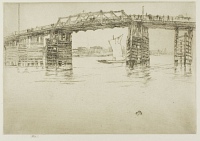Old Battersea Bridge | ||
| Number: | 188 | |
| Date: | 1879 | |
| Medium: | etching and drypoint | |
| Size: | 202 x 293 mm | |
| Signed: | butterfly at lower right (2-6); replaced with new butterfly (6); replaced again (7) | |
| Inscribed: | no | |
| Set/Publication: | Fine Art Society, 1879 | |
| No. of States: | 7 | |
| Known impressions: | 40 | |
| Catalogues: | K.177; M.174; W.141 | |
| Impressions taken from this plate (40) | ||
PUBLICATION
25: Huish to Whistler, 14 March 1879; GUW #01098.
28: GUW #02988.
The price corresponds to that quoted by Wedmore, who described Old Battersea Bridge as: 'One of the noblest, most spacious, most refined of Mr. Whistler's visions of the Thames. It was issued by the Fine Art Society, at £6. 6s.' 30 However, it would appear that Whistler, rather than Goulding, printed the edition.
29: Catalogue in Special Collections, Glasgow University Library.
30: Wedmore 1886 A[more] (cat. no. 141).
EXHIBITIONS
When the etching was shown in Birmingham in 1889, a reviewer compared Whistler's technique to the work of Rembrandt Harmens van Rijn (1617-1681):
31: 'The exhibition of works in black and white', Daily News, 1 July 1880; see also The Artist, August 1880, p. 244.
33: 'Peebles Art Exhibition', Glasgow Herald, 29 July 1898.
It was for sale in several print dealer's exhibitions, particularly by H. Wunderlich & Co. in New York in 1898 and 1903; Charles Lang Freer (1856-1919) bought two impressions from the show ( and ). 37 Other print dealers' exhibitions included F. Keppel & Co. in New York in 1899, and Obach & Co. in London in 1903.
After Whistler's death, impressions were shown in several of the Memorial shows including the comprehensive Grolier Club exhibition in New York in 1904. Frank Lusk Babbott (1854-1903) lent an impression to the Boston show organised by the Copley Society in 1904, and Henry Studdy Theobald (1847-1934) lent to the London show in 1905. 38
34: New York 1881 (cat. no. 155).
35: Glasgow 1888 (cat. no. 2552-20); Glasgow 1901 (cat. no. 230).
36: Chicago 1900 (cat. no. 123);Philadelphia 1902 (cat. no. 947 (141)). See REFERENCES: EXHIBITIONS.
37: New York 1903b (cat. no. 104).
38: New York 1904a (cat. no. 142); Boston 1904 (cat. no. 107); London Mem. 1905 (cat. no. 141).
SALES & COLLECTORS
39: GUW #09394.
40: M. B. Huish to Whistler, 14 March, 7 April and 6 August 1879, GUW #01098, #01099, #01103.
41: Robert Dunthorne at the Cabinet of Fine Arts, Vigo Street, 1881, p. 23.
An impression of the first state - listed as the '1st proof' - was sold by Whistler for a large amount, £15.15.0, to the print dealer Frederick Keppel (1845-1912) in 1891. 43 Whistler himself sold impressions to another dealer, Robert Dunthorne (b. ca 1851), in 1902 and 1903 for £12.12.0, suggesting he was a better salesman than the auction houses. 44
42: Christie's, 10 June 1887 (lot 72); 13-14 July 1897 (lot 294); 18 June 1901 (lot 125).
43: Whistler to Frederick Keppel (1845-1912), 13 May 1891, GUW #13068.
44: Whistler to Robert Dunthorne (b. ca 1851), 24 December 1902, GUW #13040, [20 April 1903], #13041.
